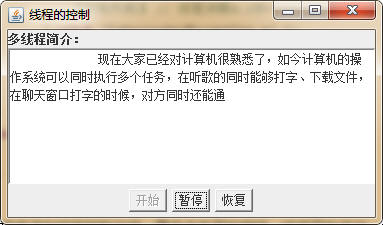一、线程接力
编写一个应用程序,除了主线程外,还有三个线程:first、second和third。first负责模拟一个红色的按钮从坐标(10,60)运动到(100,60);second负责模拟一个绿色的按钮从坐标(100,60)运动到(200,60)。third线程负责模拟一个蓝色的按钮从坐标(200,60)运动到(300,60)。
阅读并分析以下程序,将程序中的代码补充完整,编译并运行程序,查看结果。
package Demo01;
import java.awt.*;
import java.awt.event.*;
public class MoveButton extends Frame implements Runnable, ActionListener {
// 用Thread类声明first,second,third三个线程对象
Thread first, second, third;
Button redButton, greenButton, blueButton, startButton;
int distance = 10;
MoveButton() {
// 分别创建first,second,third三个线程,用当前窗口做为该线程的目标对象
first = new Thread(this);
second = new Thread(this);
third = new Thread(this);
redButton = new Button();
greenButton = new Button();
blueButton = new Button();
redButton.setBackground(Color.red);
greenButton.setBackground(Color.green);
blueButton.setBackground(Color.blue);
startButton = new Button("start");
startButton.addActionListener(this);
setLayout(null);
add(redButton);
redButton.setBounds(10, 60, 15, 15);
add(greenButton);
greenButton.setBounds(100, 60, 15, 15);
add(blueButton);
blueButton.setBounds(200, 60, 15, 15);
add(startButton);
startButton.setBounds(200, 100, 30, 30);
setTitle("线程接力");
setBounds(0, 0, 10, 200);
setVisible(true);
validate();
addWindowListener(new WindowAdapter() {
public void windowClosing(WindowEvent e) {
System.exit(0);
}
});
}
public void actionPerformed(ActionEvent e) {
try {
// 分别启动三个线程
first.start();
second.start();
third.start();
} catch (Exception exp) {
}
}
public void run() {
while (true) {
// 判断当前占有CPU资源的线程是否是first
if (Thread.currentThread() == first) {
moveComponent(redButton);
try {
Thread.sleep(20);
} catch (Exception exp) {
}
}
// 判断当前占有CPU资源的线程是否是second
if (Thread.currentThread() == second) {
moveComponent(greenButton);
try {
Thread.sleep(10);
} catch (Exception exp) {
}
}
// 判断当前占有CPU资源的线程是否是third
if (Thread.currentThread() == third) {
moveComponent(blueButton);
try {
Thread.sleep(20);
} catch (Exception e) {
}
}
}
}
public synchronized void moveComponent(Component b) {
if (Thread.currentThread() == first) {
while (distance > 100 && distance <= 300)
try {
wait();
} catch (Exception exp) {
}
distance = distance + 1;
b.setLocation(distance, 60);
if (distance >= 100) {
b.setLocation(10, 60);
notifyAll();
}
}
if (Thread.currentThread() == second) {
while ((distance >= 10 && distance < 100) || (distance >200 && distance <= 300))
try {
wait();
} catch (Exception exp) {
}
distance = distance + 1;
b.setLocation(distance, 60);
if (distance > 200) {
b.setLocation(100, 60);
notifyAll();
}
}
if (Thread.currentThread() == third) {
while (distance >= 10 && distance < 200)
try {
wait();
} catch (Exception exp) {
}
distance = distance + 1;
b.setLocation(distance, 60);
if (distance > 300) {
distance = 10;
b.setLocation(200, 60);
notifyAll();
}
}
}
public static void main(String[] args) {
new MoveButton().setLocationRelativeTo(null);
}
}
二、线程的控制
编写一个程序,动画显示文本域中的字符串。在窗体的南面添加三个按钮,为程序添加线程控制功能,要求点击开始按钮(startBtn),线程开始启动,文字逐个显示,并且将按钮状态改变为禁用(因为线程不能重复启动);点击暂停按钮(pauseBtn),线程暂停,文字显示停止;点击恢复按钮(resumeBtn),线程恢复运行,文字继续显示。当线程执行完毕后,恢复开始按钮的状态为可用。程序运行界面如下图所示:

package Demo01;
import java.awt.*;
import java.awt.event.ActionEvent;
import java.awt.event.ActionListener;
import javax.swing.*;
import javax.swing.border.BevelBorder;
public class RunnableDemo extends JFrame implements Runnable, ActionListener {
private JTextArea textArea; // 文本域组件
JLabel label;
Button startBtn, pauseBtn, resumeBtn;
Panel panel;
Thread thread;
boolean move = false;
// 动画显示的文本字符串
private String introduction = "现在大家已经对计算机很熟悉了,如今计算机的操作"
+ "系统可以同时执行多个任务,在听歌的同时能够打字、下载文件,在聊天窗口打"
+ "字的时候,对方同时还能通过视频看到你;听到你。这一切都是使用多任务实现"
+ "的,Java语言使用多线程实现一个程序中的多个任务同时运行。程序员可以在程"
+ "序中执行多个线程,每一个线程完成一个功能,并与其他线程并发执行,这种机"
+ "制被称为多线程。";
public static void main(String args[]) {
new RunnableDemo().setLocationRelativeTo(null); // 创建本类实例对象
}
public RunnableDemo() {
setTitle("线程的控制");
label = new JLabel("多线程简介:"); // 标签组件
getContentPane().add(label, BorderLayout.NORTH);// 添加标签到窗体
textArea = new JTextArea("\t"); // 初始化文本域组件
textArea.setBorder(new BevelBorder(BevelBorder.LOWERED));// 设置边框
textArea.setLineWrap(true); // 设置自动折行
getContentPane().add(textArea, BorderLayout.CENTER);// 添加文本域组件到文本框
startBtn = new Button("开始");
pauseBtn = new Button("暂停");
resumeBtn =new Button("恢复");
startBtn.addActionListener(this);
pauseBtn.addActionListener(this);
resumeBtn.addActionListener(this);
panel = new Panel();
panel.add(startBtn);
panel.add(pauseBtn);
panel.add(resumeBtn);
getContentPane().add(panel, BorderLayout.SOUTH);
setBounds(0, 0, 383, 225); // 设置窗体大小位置
setDefaultCloseOperation(JFrame.EXIT_ON_CLOSE);
setVisible(true); // 显示窗体
}
/** Runnable接口方法,是线程的执行方法 */
@Override
public void run() {
textArea.setText("\t");
String[] intros = introduction.split(""); // 将字符串分割为数组
for (String ch : intros) { // ForEach遍历字符串数组
while (!move) {
try {
synchronized (this) {
wait();
}
} catch (InterruptedException e) {
e.printStackTrace();
}
}
textArea.append(ch); // 添加一个字符到文本域
try {
Thread.sleep(100); // 线程休眠0.1秒
} catch (InterruptedException e) {
e.printStackTrace();
}
}
startBtn.setEnabled(true);
}
@Override
public void actionPerformed(ActionEvent e) {
if (e.getSource() == startBtn) {
thread = new Thread(this);
thread.start();
move = true;
startBtn.setEnabled(false);
} else if (e.getSource() == pauseBtn) {
move = false;
} else if (e.getSource() == resumeBtn) {
move = true;
synchronized (this) {
notifyAll();
}
}
}
}




















 556
556











 被折叠的 条评论
为什么被折叠?
被折叠的 条评论
为什么被折叠?








